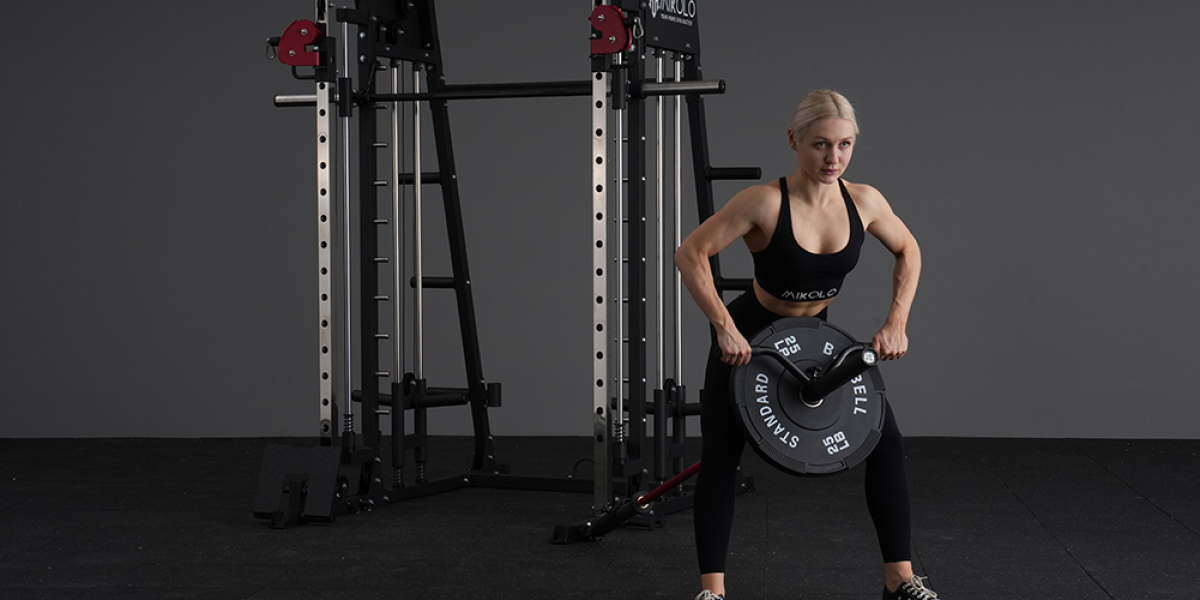When it comes to building strength and sculpting muscle, the Smith machine stands out as a versatile and reliable piece of equipment. Loved by beginners and experienced lifters alike, it allows for controlled, safe movements that reduce the risk of injury while still delivering an intense workout. In this guide, we’ll break down everything you need to know about the MIKOLO Smith machine, its benefits, common exercises, and how to get the most out of it.
What Is a Smith Machine?
A Smith machine is a weight-training apparatus that consists of a barbell fixed within steel rails, allowing vertical or near-vertical movement. The bar is attached to the rails, which means it only moves in a straight path. This feature makes the Smith machine different from a traditional free-weight barbell, where the lifter must balance the bar while moving it.
The Smith machine often has safety catches, allowing the lifter to “lock” the barbell into place at any point during the exercise. This makes it ideal for those who train alone or want added security while lifting heavy.
Benefits of Using a Smith Machine
Enhanced Safety: The fixed path of the bar reduces the risk of losing balance, making it safer for those new to weightlifting or when lifting heavy weights alone.
Targeted Muscle Engagement: By stabilizing the bar, the Smith machine allows you to focus on specific muscle groups. This is particularly useful for exercises like squats and presses, where form and control are critical.
Versatility: A Smith machine can be used for a wide range of exercises, from squats and deadlifts to bench presses and calf raises. It’s an all-in-one station for total body workouts.
Great for Beginners: For those just starting out, the Smith machine helps guide your movements, ensuring proper form and reducing the chances of injury.
Smith Machine vs Free Weights: Which Is Better?
Both Smith machines and free weights have their pros and cons. While free weights provide a more dynamic workout by engaging stabilizing muscles, the Smith machine offers added safety and control. Many lifters use both in their routines to get the benefits of each.
Key Differences:
- Range of Motion: Free weights allow for a natural range of motion, while the Smith machine limits your movement to a fixed path.
- Stabilization: Free weights require more balance and coordination, engaging stabilizer muscles, whereas the Smith machine removes the need for stabilization.
- Safety: The Smith machine is generally safer for those lifting alone or trying to push heavy weights without a spotter.
Common Smith Machine Exercises
- Smith Machine Squats
- Target muscles: Quadriceps, hamstrings, glutes
- How to perform: Stand under the bar, place it across your upper back, and squat down, ensuring your knees stay behind your toes.
- Smith Machine Bench Press
- Target muscles: Chest, shoulders, triceps
- How to perform: Lie on a bench beneath the bar, lower it to your chest, and press upwards.
- Smith Machine Deadlifts
- Target muscles: Hamstrings, glutes, lower back
- How to perform: Grip the bar with your hands shoulder-width apart, hinge at the hips, and lift the bar by straightening your legs and back.
- Smith Machine Overhead Press
- Target muscles: Shoulders, triceps
- How to perform: Stand with the bar at shoulder height, push the bar overhead, and lower it back down slowly.
- Smith Machine Lunges
- Target muscles: Quadriceps, glutes, hamstrings
- How to perform: Step one foot forward under the bar, lunge down, and press back up to the starting position.
How to Use the Smith Machine for Beginners
Start with Light Weights: If you’re new to the Smith machine, begin with lighter weights to get a feel for the movement and build your confidence.
Check Your Form: Just because the bar is on a fixed path doesn’t mean form isn’t important. Ensure you’re using the correct posture, especially with exercises like squats and deadlifts.
Adjust the Safety Catches: Always set the safety stops at the correct height before starting your exercise. This ensures that if you can’t complete a rep, you can lock the bar into place.
Gradually Increase Weight: Once you’re comfortable with the movement patterns, increase the weight gradually to continue challenging your muscles without sacrificing form.
Advanced Smith Machine Workouts
For more experienced lifters, the Smith machine offers a chance to push yourself with controlled, heavy lifting. Some advanced workout techniques include:
- Drop Sets: Perform a set to failure, lower the weight, and immediately do another set with no rest in between. Repeat for multiple sets.
- Partial Reps: Focus on a portion of the range of motion, particularly at the top or bottom of the lift, to target specific muscle groups.
- Time Under Tension: Slow down the eccentric (lowering) phase of the lift to keep the muscles under tension for longer, increasing muscle growth.
Is the Smith Machine Right for You?
The Smith machine is excellent for anyone looking to build strength in a controlled and safe environment. It’s particularly useful for beginners, those recovering from injury, or anyone working out without a spotter. While it shouldn’t replace free weights entirely, it can complement your strength training routine by providing a safer and more stable way to perform many key lifts.
Final Thoughts
Whether you’re a seasoned gym-goer or just starting your fitness journey, the Smith machine offers a range of benefits to help you achieve your goals. Its stability, versatility, and safety features make it an essential piece of equipment for anyone serious about strength training. With proper form and a well-rounded routine, the Smith machine can help you build muscle, increase strength, and boost your overall fitness.









